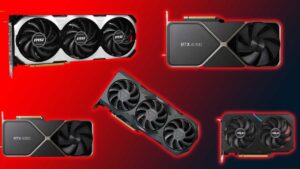Introduction:
The semiconductor industry stands at the forefront of technological innovation, driving progress across various sectors and shaping the future of technology. In this article, we’ve curated 5 must-watch talks that delve into the opportunities and future trends within the semiconductor industry.
From discussions on emerging technologies to insights into market dynamics, these talks offer valuable perspectives for industry professionals and enthusiasts alike.
Join us as we explore the forefront of semiconductor advancements and envision the possibilities that lie ahead.
Follow us on LinkedIn for everything around Semiconductors & AI
Semiconductor Landscape: Insights and Perspectives from Industry Leaders
The semiconductor industry stands as a cornerstone of modern technological advancement, underpinning the very foundations of our digital world. Such as the microprocessors powering our computers to the intricate circuitry within our smartphones, semiconductors drive innovation across countless sectors. However, as the industry continues to evolve at a rapid pace, navigating its complexities and seizing opportunities requires a nuanced understanding of its present landscape and future trajectory.
In this era of rapid technological advancement, staying abreast of the latest trends and insights is paramount for professionals, enthusiasts, and investors alike.
To shed light on the opportunities and challenges within the semiconductor industry, we present a curated selection of five must-watch talks. SThese talks delve into various aspects of semiconductor technology, market dynamics, and future prospects, offering invaluable perspectives from industry experts and thought leaders.
Whether you’re a seasoned veteran or a curious newcomer, these talks promise to enlighten and inspire, providing a glimpse into the fascinating world of semiconductors.
Read More: How Nanoimprint Lithography Can Revolutionize Manufacturing – techovedas
5 Must Watch Talks on Semiconductor Industry
1. ISSCC 2003 Gordon Moore Plenary Presentation
Summary
- The semiconductor industry has shown exponential growth in revenues and the number of transistors shipped per year.
- The industry has experienced significant dips and bumps, including layoffs, but has overall maintained steady growth.
- The average cost per transistor has dropped significantly over the years.
- The development of integrated circuits faced initial resistance but eventually became the cheaper and more efficient option.
- Moore’s Law accurately predicted the exponential growth in complexity and density of circuits on a chip.
- Wafer sizes and the number of metal layers in circuits have increased significantly over time.
- Advancements in technology have allowed for smaller and smaller features to be developed, pushing the boundaries of nanotechnology.
2. Open-Source IC Design: Viewpoints from Academic and Industry
Summary
This webinar is about open-source IC design viewpoints from academic and industry. The speakers are Matthew Gutas and Kristoff Sander. The webinar will last for over an hour and will include a Q&A session. Attendees have the opportunity to earn a certificate of participation.
Highlights
🎓 Webinar on open-source IC design viewpoints
💼 Presented by Matthew Gutas and Kristoff Sander
🕒 Over an hour long with Q&A session
📜 Certificate of participation available
📺 Webinar video and slides posted on SSCS YouTube channel
❓ Q&A section available for questions
🌐 Webinars for Young Excellence initiative by SSCS
3. Semiconductor Industry: Present & Future (Kevin Zhang)
Summary
The speaker, Dr. Kevin Zhang, discusses the present and future of the semiconductor industry.Additionally,he highlights the importance of semiconductors in various sectors and the significant growth expected in the industry. He also talks about the business innovation of the semiconductor industry and the advancements in transistor architecture and materials. Additionally, he discusses the challenges and potential solutions for future high-performance computing, such as 3D stacking and silicon photonics.
Highlights
💡 Semiconductor industry revenue expected to double by the end of the decade.
💡 Accelerated growth period for semiconductors due to the rise of AI.
💡 Importance of advanced silicon technology in wireless communication and automotive industry.
💡The business innovation of the pure-play foundry model has revolutionized such as the semiconductor industry, thereby enabling efficiency, flexibility, and scalability.
💡 Advancements in transistor architecture and materials, such as the introduction of Nanosheet and Cfat transistors.
💡 Design-technology co-optimization (DTCO) enhances performance, density, and power consumption of semiconductor devices, such as advancing innovation and competitiveness.
💡Future high-performance computing will necessitate 3D stacking and silicon photonics, such as enabling higher interconnect density and communication capabilities. Additionally, these advancements will significantly enhance overall computing efficiency.
4. Computing in the Era of Generative AI (Jonah Alben)
Summary
Jonah Alban, senior vice president of GPU engineering at Nvidia, discusses generative AI and its impact on various industries. He highlights the capabilities of generative AI in creating work from simple prompts and the potential applications in fields such as summarization and coding. Alban also emphasizes the importance of hardware advancements in enabling larger and more powerful AI models.
Highlights
💡 Generative AI has revolutionized the field of AI by allowing models such as create work from simple prompts.
💡 Multimodal intelligence, which combines various types of data such as text, videos, and images, enhances the capabilities of AI models.
💡 Industrial applications of generative AI, such as summarization and coding, hold great potential.
💡 Hardware advancements, such as larger models and specialized processors, have played a crucial role in the progress of AI.
💡 AI poses challenges in terms of compute power, memory, data transfer, and system reliability.
💡Nvidia’s GPUs have been specifically tailored for AI workloads, equipped with features like tensor cores and high-speed networking interfaces, enabling unparalleled performance.
💡 The field of generative AI offers exciting
Read More: Win a Grant to Hawaii – The IEEE “Code-a-Chip” Travel Program – techovedas
5. ISSCC 2013: Lisa Su, Architecting the Future through Heterogeneous Computing
Summary
Lisa Su discusses the future of heterogeneous computing at ISSCC 2013.
Highlights
💡 Heterogeneous computing is the future of technology.
💻 It involves combining different types of processors to optimize performance and power efficiency.
🌐 Heterogeneous computing enables better utilization of resources, thereby enhancing user experiences and improving overall system efficiency.
🚀 It enables seamless integration of various applications and services.
🔬The key challenge lies in efficiently managing the diverse components and ensuring interoperability, thus facilitating seamless integration and optimal performance.Consequently, addressing this challenge is essential for achieving successful outcomes.
💪 Lisa Su believes that heterogeneous computing will drive innovation and revolutionize industries by integrating diverse technologies and optimizing performance, consequently leading to transformative advancements.
🌟 It is important to architect the future of computing with a focus on heterogeneous systems.



